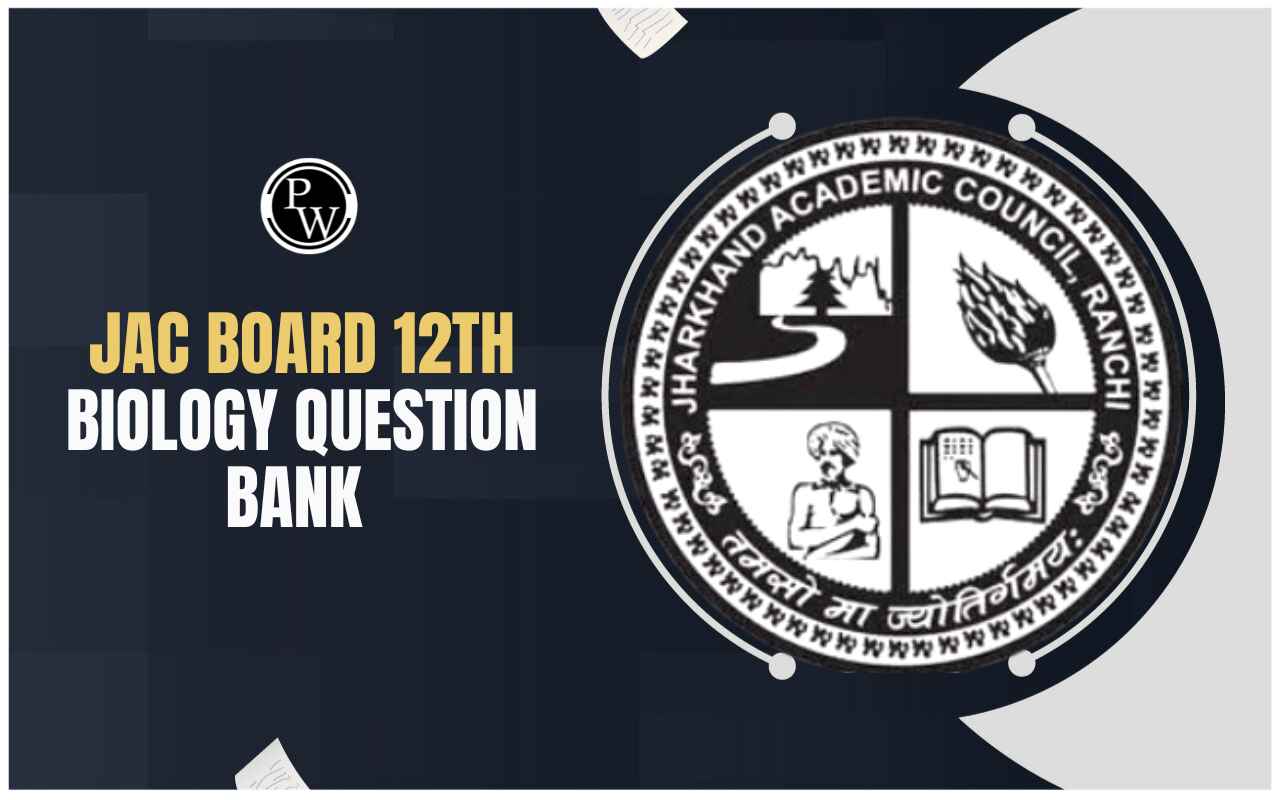
JAC Board Class 11th Biology Syllabus 2025-26: The Jharkhand Academic Council (JAC) officially releases the Class 11 Biology syllabus for the academic year, helping students understand the syllabus for the academic year. The syllabus is structured in such a way that it helps teachers as well to plan the lectures weekly and monthly.
Students who opt for Science stream must begin their preparation for all the subjects (Physics, Chemistry, and Biology). They must carefully go through this syllabus to understand the subject structure and practical they are required to perform.
Biology at this level forms the foundation for future medical or life science studies. The syllabus introduces core biological principles, plant and animal physiology, genetics, and biotechnology while also giving students hands-on experience through practicals.
JAC Board Class 11th Biology Syllabus 2025-26 Overview
The JAC Board has created the Class 11 Biology syllabus to provide a strong conceptual base in Life Sciences. This syllabus is ideal for students planning to appear for NEET and other biology-related entrance exams in the future. It includes theoretical chapters from botany and zoology, as well as practical skills to improve their scientific observation and experimentation. Here is the JAC Board Class 11th Biology Syllabus 2025-26 Overview:
|
JAC Board Class 11th Biology Syllabus 2025-26 Overview |
|
|
Particulars |
Details |
|
Board |
Jharkhand Academic Council (JAC) |
|
Class |
11th |
|
Subject |
Biology |
|
Academic Session |
2025–26 |
|
Total Marks |
100 (Theory: 70 + Practical: 30) |
|
Exam Duration |
3 Hours |
|
Official Website |
|
JAC Board Class 11th Biology Syllabus 2026 Exam Pattern
The JAC Board follows the OMR-based format, covering the entire syllabus (100%) for the Class 11 Biology examination for 2025. The paper consists of multiple-choice questions (MCQs) only, and students must fill in the correct options on the OMR sheet.
This objective-based exam format requires a strong understanding of concepts and effective time management. Here is the JAC Board Class 11th Biology Syllabus 2026 Exam Pattern:
|
JAC Board Class 11th Biology Syllabus 2026 Exam Pattern |
|
|
Component |
Details |
|
Board Exam |
Class 11 |
|
Stream |
Science |
|
Syllabus |
100% of prescribed topics |
|
Exam Type |
OMR-Based |
|
Question Type |
Multiple Choice Questions (MCQs) |
|
Total Exam Marks |
250 (For Annual Examination) |
JAC Board Class 11th Biology Syllabus 2025-26 Download PDF
JAC Board Class 11th Biology Syllabus 2025-26 helps students understand the chapters and sub-topics included in the curriculum. Students must download the syllabus as the first step towards their preparation. This will help them to make a study time table based on the importance of each chapter. You can download the syllabus PDF from here:
JAC Board Class 11 Biology Syllabus 2025-26
Study without using the internet
JAC Board Class 11th Biology Syllabus 2025-26
The Class 11 Biology syllabus is broad and divided into major units such as the diversity of living organisms, structural organisation, plant and animal physiology, cell structure, and biomolecules. Below is the chapter-wise list of topics:
1. The Living World
Ernst Mayr and Introduction
1.2 Diversity in the Living World
1.3 Taxonomic Categories
1.3 Species
1.3 Genus
1.3 Family
1.3 Order
1.3 Class
1.3 Phylum
1.3 Kingdom
Summary and Exercise
2. Biological Classification
Introduction
2.1 Kingdom Monera
2.1.1 Archaebacteria
2.1.2 Eubacteria
2.2 Kingdom Protista
2.2.1 Chrysophytes
2.2.2 Dinoflagellates
2.2.3 Euglenoids
2.2.4 Slime Moulds
2.3 Kingdom Fungi
2.3.1 Phycomycetes
2.3.2 Ascomycetes
2.3.3 Basidiomycetes
2.3.4 Deuteromycetes
2.4 Kingdom Plantae
2.5 Kingdom Animalia
2.6 Viruses, Viroids, Prions and Lichens
Summary and Revision
3. Plant Kingdom
Introduction
3.1 Algae
3.1.1 Chlorophyceae
3.1.2 Phaeophyceae
3.1.3 Rhodophyceae
3.2 Bryophytes
3.2.1 Liverworts
3.2.2 Mosses
3.3 Pteridophytes
3.4 Gymnosperms
3.5 Angiosperms
3.6 Plant Life Cycles and Alternation of Generations
Summary and Exercise
4. Animal Kingdom
Introduction
4.1 Basis of Classification
4.1.1 Levels of Organisation
4.1.2 Symmetry
4.1.3 Diploblastic and Triploblastic Organisation
4.1.4 Coelom
4.1.5 Segmentation
4.1.6 Notochord
4.2 Classification of Animals
4.2.1 Phylum – Porifera
4.2.2 Phylum – Coelenterata (Cnidaria)
4.2.3 Phylum – Ctenophora
4.2.4 Phylum – Platyhelminthes
4.2.5 Phylum – Aschelminthes
4.2.6 Phylum – Annelida
4.2.7 Phylum – Arthropoda
4.2.8 Phylum – Mollusca
4.2.9 Phylum – Echinodermata
4.2.10 Phylum – Hemichordata
4.2.11 Phylum – Chordata
4.2.11.1 Class – Cyclostomata
4.2.11.2 Class – Chondrichthyes
4.2.11.3 Class – Osteichthyes
4.2.11.4 Class – Amphibia
4.2.11.5 Class – Reptilia
4.2.11.6 Class – Aves
4.2.11.7 Class – Mammalia
Summary and Exercise
5. Morphology of Flowering Plants
Katherine Esau and Introduction
5.1 The Root
5.1.1 Regions of the Root
5.2 The Stem
5.3 The Leaf
5.3.1 Venation
5.3.2 Types of Leaves
5.3.3 Phyllotaxy
5.4 The Inflorescence
5.5 The Flower
5.5.1 Parts of a Flower
5.5.2 Calyx
5.5.3 Corolla
5.5.4 Androecium
5.5.5 Gynoecium
6. Anatomy of Flowering Plants
Introduction
6.2 The Tissue System
6.2.1 Epidermal Tissue System
6.2.2 The Ground Tissue System
6.2.3 The Vascular Tissue System
6.3 Anatomy of Dicotyledonous and Monocotyledonous Plants
6.3.1 Dicotyledonous Root
6.3.2 Monocotyledonous Root
6.3.3 Dicotyledonous Stem
6.3.4 Monocotyledonous Stem
6.3.5 Dicotyledonous Leaf (Monocotyledonous Leaf)
6.3.6 Isobilateral (Monocotyledonous) Leaf
Summary and Exercise
7. Structural Organisation in Animals
Introduction
7.2 Organ and Organ System
7.5 Frogs
7.5.1 Morphology
7.5.2 Anatomy
Summary and Exercise
8. Cell: The Unit of Life
8.1 N Ramachandran and Introduction
8.1 What is a Cell?
8.2 An Overview of Cell
8.3 Prokaryotic Cell
8.4 Cell Envelope and its Modifications
8.4.2 Ribosomes and Inclusion Bodies
8.5 Eukaryotic Cells
8.5.1 Cell Membrane
8.5.2 Cell Wall
9. Cell: The Unit of Life (continued)
8.5.3 Endomembrane System
8.5.3.1 The Endoplasmic Reticulum
8.5.3.2 Golgi Apparatus
8.5.3.3 Lysosomes
8.5.3.4 Vacuoles
8.5.4 Mitochondria
8.5.5 Plastids
8.5.6 Ribosomes
8.5.7 Cytoskeleton
8.5.8 Cilia and Flagella
8.5.9 Centrosome and Centriole
8.5.10 Nucleus
Summary and Revision
10. Biomolecules
Introduction
9.1 How to analyse chemical composition?
9.2 Primary and Secondary Metabolites
9.3 Biomacromolecules
9.4 Proteins
9.5 Polysaccharides
9.6 Nucleic Acids
9.7 Structure of Proteins
9.12 Enzymes
9.12.1 Chemical Reactions
9.12.2 How do Enzymes bring about such High Rates of Chemical Conversions?
9.12.3 Nature of Enzyme Action
9.12.4 Factors affecting Enzyme activity
9.12.5 Classification and Nomenclature of Enzymes
9.12.6 Co-Factors
Summary and Exercise
11. Cell Cycle and Cell Division
10.1 Cell Cycle
10.1.1 Phases of Cell Cycle
10.2 Mitosis
10.2.1 Prophase
10.2.2 Metaphase
10.2.3 Anaphase
10.2.4 Telophase
10.2.5 Cytokinesis
10.3 Significance of Mitosis
12. Plant Growth and Development
Development
Plant Growth Regulators
Characteristics
The Discovery of Plant Growth Regulators
Physiological Effects of Plant Growth Regulators
Auxins
Gibberellins
Cytokinins
Ethylene
Abscisic Acid
Summary and Exercise
13. Breathing and Exchange of Gases
Introduction
Respiratory Organs
Human Respiratory System
Mechanism of Breathing
Respiratory Volumes and Capacities
Exchange of Gases
Transport of Gases
Transport of Oxygen
Transport of Carbon Dioxide
Regulation of Respiration
Disorders of Respiratory System
Summary
14. Body Fluids and Circulation
Introduction
Blood
Plasma
Formed Elements
Blood Groups
ABO grouping
Rh grouping
Composition of Blood
Lymph (Tissue fluid)
Circulatory Pathways
15. Body Fluids and Circulation (continued)
Human Circulatory System
Cardiac Cycle
Electrocardiograph (ECG)
Double Circulation
Regulation of Cardiac Activity
Disorders of Circulatory System
Summary
16. Excretory Products and their Elimination
Introduction
Human Excretory System
Urine Formation
Function of the Tubules
Regulation of Kidney Function
Micturition
Role of other Organs in Excretion
Disorders of Excretory System
Summary, Revision and Exercise
17. Locomotion and Movement
Introduction
Types of Movement
Muscle
Mechanism of Contractile Proteins
Function of Muscle
Skeletal System
Joints
Disorders of Muscular and Skeletal Systems
Summary, Revision and Exercise
18. Neural Control and Coordination
Introduction
Neural System
Human Neural System
Neuron and Structural and Functional Unit of Neural System
Generation and Conduction of Nerve Impulse
Transmission of Impulses
Central Nervous System
Forebrain
Midbrain
Hindbrain
Summary, Revision and Exercise
19. Chemical Coordination and Integration
Introduction
Endocrine Glands and Hormones
Human Endocrine System
The Hypothalamus
The Pituitary Gland
The Pineal Gland
Thyroid Gland
Parathyroid Gland
Thymus
Adrenal Gland
Pancreas
Testis
Ovary
Hormones of Heart, Kidney and Gastrointestinal Tract
Mechanism of Hormone Action & Summary
You must make sure that you complete the syllabus during the academic year and understand every concept thoroughly.
JAC Board Class 11th Physics Syllabus
JAC Board Class 11th Biology Syllabus 2026 Practical
JAC Class 11th Biology Syllabus 2026 also includes a section of practical examination. The syllabus includes both plant and animal-based experiments. Here is the list of practical activities mentioned in the official syllabus:
-
Study parts of a compound microscope.
-
Study of the specimens and identification with reasons – Bacteria, Oscillatoria, Spirogyra, Rhizopus, mushroom, Yeast, liverwort, moss, fern, Pinus, one monocotyledon and one dicotyledon and one lichen.
-
Study of specimen and identification with reasons – Amoeba, Hydra, liverfluke, Ascaris, leech, earthworm, prawn, silk worm, honeybee, snail, star fish, shark, rohu, frog, lizard, pigeon and rabbit.
-
Study of tissues, and diversity in shapes and sizes of plant and animal cells (e.g., palisade cells, guard cells, parenchyma, collenchyma, sclerenchyma, xylem, phloem, squamous epithelium, muscle fibre and mammalian blood smear) through temporary/permanent slides.
-
Study of mitosis in onion root tip cells and animal cells (grasshopper) (permanent slides).
-
Preparation and study of T.S. dicot and monocot roots and stems (normal).
-
Study and identify different types of inflorescences.
-
Study and describe three common flowering plants (Solanaceae).
-
Observation and comments on the experimental setup on:
(a) Phototropism
(b) Apical bud removal -
Study external morphology of frog through models.
-
Test for the presence of sugar, starch, proteins and fats. Detect them in suitable plant and animal materials.
-
To test the presence of urea in urine.
-
To detect the presence of albumin in urine.
-
To detect the presence of bile salts in urine
-
To study human skeleton and different types of joints.
How to Prepare for JAC Board Class 11th Biology Exam 2025-26?
Students must follow specific preparation tips to prepare for the JAC Board Class 11th Biology Exam 2025-26. Here are some tips through which you can build a strong foundation and perform well in your annual exam:
-
The JAC syllabus follows NCERT textbooks, so make sure you thoroughly understand every concept, definition, and diagram. Don’t skip examples or in-text questions as they often form the basis of MCQs.
-
Practice drawing and correctly labelling diagrams from chapters like Morphology of Plants, Anatomy of Flowering Plants, Cell Structure, and Human Skeleton. Visual memory will help you perform better in understanding basic concepts.
-
For memory-heavy chapters like Plant Kingdom and Animal Kingdom, create short notes as it makes it easier for you to remember complex scientific names and hierarchies.
-
Since the Biology exam is OMR-based, regularly solve previous years’ question papers and mock tests on actual OMR sheets. This will help you improve your speed and accuracy.
-
Make concise notes for chapters like Cell Cycle, Photosynthesis, and Enzymes for quick revision.
JAC Board Class 11th Biology Syllabus 2026 FAQs
Will class 11 syllabus change in 2025?
What is the passing marks for JAC 11th 2025?
Does Jac Board follow NCERT?
How to study for JAC board?










